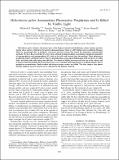Helicobacter pylori Accumulates Photoactive Porphyrins and Is Killed by Visible Light

View/
Author
Viveiros, J.
Ahmadi, A.
Ganz, R. A.
Tolkoff, M. J.
Yang, Changming
Published Version
https://doi.org/10.1128/aac.49.7.2822-2827.2005Metadata
Show full item recordCitation
Hamblin, M. R., J. Viveiros, C. Yang, A. Ahmadi, R. A. Ganz, and M. J. Tolkoff. 2005. “Helicobacter Pylori Accumulates Photoactive Porphyrins and Is Killed by Visible Light.” Antimicrobial Agents and Chemotherapy 49 (7): 2822–27. https://doi.org/10.1128/aac.49.7.2822-2827.2005.Abstract
Helicobacter pylori colonizes the mucus layer of the human stomach and duodenum, causes chronic gastritis, gastric ulcer, and is a risk factor for gastric adenocarcinoma. There is a 20% failure rate in antibiotic therapy, which is increasingly due to antibiotic resistance and necessitates the search for alternative antimicrobial methods. We have discovered that H. pylori when cultured in liquid medium, accumulates significant quantities of coproporphyrin and protoporphyrin IX, both in the cells and secreted into the medium. These photoactive porphyrins lead to cell death (up to 5 logs) by photodynamic action upon illumination with low doses of visible light, with blue/violet light being most efficient. The degree of killing increases with the age of the culture and is greater than that found with Propionibacterium acnes (another bacterium known to be photosensitive due to porphyrin accumulation). Both virulent and drug-resistant strains are killed. The data suggest that phototherapy might be used to treat H. pylori infection in the human stomach.Terms of Use
This article is made available under the terms and conditions applicable to Other Posted Material, as set forth at http://nrs.harvard.edu/urn-3:HUL.InstRepos:dash.current.terms-of-use#LAACitable link to this page
http://nrs.harvard.edu/urn-3:HUL.InstRepos:37933095
Collections
- HMS Scholarly Articles [17922]
Contact administrator regarding this item (to report mistakes or request changes)


